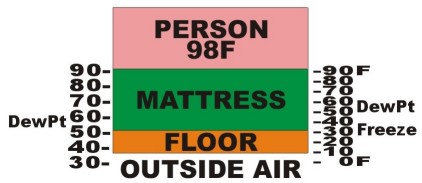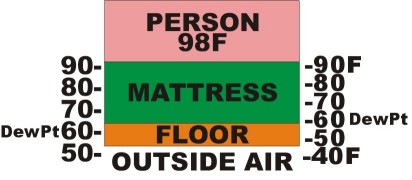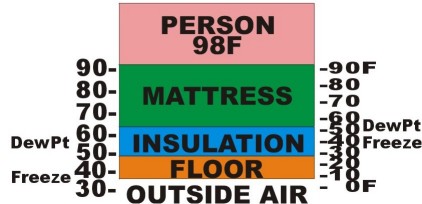It might help if I describe what is happening that causes the condensation problem. I have explained this to several of our "cold weather" customers. It helped to have them in front of me so I could sketch out some diagrams. Since you aren't here, I drew up some pictures and I will try to explain them the best that I can....
When you are sleeping your body gives off water vapor, either in your breath, or from perspiration. This is the source of the water that condenses on the inside of your camper in cold weather. Even when it is cold out, your skin will give off a tiny amount of water vapor.
For starters, look at the first picture. It shows a person sleeping on top of a mattress which sits on the floor of the camper. (Look at the scale on the left side) Let us say that the body is warm (98 degrees F) and the outside air temperature is 50ºF. It stands to reason that there must be a point somewhere between the two that is 80ºF. There must also be a point that is 70ºF and so on...
Let us assume the dew point (the point at which water vapor condenses to form liquid water) is at say 60F. There is a point at which it is 60ºF and therefore condensation should occur, but only if there is water vapor present. Since on the left hand scale, that point (60ºF) is inside the floor,no condensation will occur. Since everything INSIDE the floor is ABOVE the dew point, no condensation will occur above the floor.
Now look at the right side scale. We have lowered the outside air temperature to 40ºF. This in effect >squeezes< the temperatures closer together. In this case, we see that the dew point is just above the floor. any water vapor that reaches this area will condense.
Now look at the next picture. On the left I have lowered the outside temperature to 30ºF, just below freezing. This >squeezes< the temperatures closer together yet. In colder weather, the dew point usually drops, so I have shown it at about 55ºF. Since the dew point is slightly into the bottom of the mattress, condensation will form below the mattress. Since the mattress is porous, some water vapor is inside it and that water vapor will condense INSIDE the mattress. This is why it is important to air out your camper fully when you have been camping in cold weather.

On the right side scale, I have lowered the outdoor temperature to 0ºF. We can now see that the temperatures are squeezed even more. The dew point is well inside the mattress. Also, if you notice, the bottom side of the mattress is at the freezing point (32ºF). Any liquid water that gets down there will freeze into ice. Water vapor that gets to that area will freeze as frost. If you camp for extended periods of time a significant amount of ice will accumilate.
Now, lets look at the third picture. Here I have added a little foam insulation between the floor and the mattress. This helps to spread out the temperatures. Now on the left scale, the dew point is inside the insulation. IF the insulation is not porous, there will not be any condensation there. Since everything above the insulation is above the dew point, no condensation forms in the mattress. But, notice that the area between the insulation and the floor is below the dew point. Any water vapor that makes it there will condense. So in this scenario, you will still get water condensing on the floor.
On the right scale, we see that even with the insulation added, we could get condensation under the mattress, since the dew point is there. Since the area between the insulation and floor is below freezing, we will get ice and frost there.
Camp-Inn trailers were designed to be three season campers. They were not designed for extended camping in sub freezing temperatures. Even so, there are a few things that you can do to extend the camping season:
1. If you open the roof vent or side windows during cold weather, more of the water vapor will "blow away" and won't have a chance to condense inside the camper.
2. When camping in cold weather, it is important to "air out" your camper when you get home. You may want to bring the mattress indoors where it is heated and let it dry for several days before returning it to the camper.
3. If you are camping for extended periods in cold weather,(week or longer)you may want to add some insulation below the mattress to minimize condensation and ice formation. If the ice stays frozen, it won't cause any problems. When it warms and thaws, wipe up as much water as possible.
4. A plastic sheet (bedwetting sheets)over the mattress will reduce the amount of water vapor penetrating the mattress and reduce condensation inside the mattress.
5. Dampness is not a concern if you air out your trailer whenever possible.
6. Water pooling is a problem and will need to we wiped up ASAP.
7. As Sherry recommended, this pad adds a little insulation but more importantly adds ventilation below the mattress so any water that condenses there has a chance to evaporate when the air temperature rises.
Hope this helps.



